First exchange student for Biodesign Institute Europe bridges labs 5,000 miles apart

PhD student Grace Colley is the first to participate in the Biodesign Institute Europe student exchange program. Photo by Andy DeLisle
This spring semester, Grace Colley traveled to Arizona State University and became the first student to participate in the Biodesign Institute Europe student exchange program. In doing so, she helped forge a path for future exchanges and collaborations across the Atlantic.
Colley is a PhD student at Dublin City University in Ireland, where she studies triple-negative breast cancer and whether existing drugs may be able to help treat it.
Triple-negative breast cancer is a highly aggressive type of breast cancer in which the cells lack three features — two hormone receptors and one protein — found in other types. This makes it more difficult to target for treatment.
Colley’s research made her a perfect fit for the Biodesign Virginia G. Piper Center for Personalized Diagnostics, which focuses on finding ways to detect diseases and understand how they work at a molecular level.
Her supervisor at DCU encouraged Colley to apply for the exchange program because it would give her access to special cell lines that aren’t available to test at home. These cell lines allow for closer study of different drugs’ effects on triple-negative breast cancer.
“Here at ASU Biodesign Institute, they've developed a panel of cell lines which have various mutations in a specific gene of interest. This allowed us to assess these mutations without any background noise,” Colley says.
Colley hopes to use drugs approved for other types of breast cancers and repurpose them to treat triple-negative breast cancer. She tested drugs individually and in combination on these mutated cell lines. While the cancer cells may be able to resist one drug, two drugs together may be able to overcome the cells’ resistance.
Colley worked primarily in the cell culture station in the lab of Jin Park, an associate research professor at the center.
“The student exchange program provides unique opportunities for students to experience new scientific perspectives, directions and technologies often unavailable within their home institution," Park explains.
"For instance, Grace has delved into and applied new bioinformatics methodologies to identify new drug targets based on data produced in the center, which can augment her research endeavors focusing on developing novel drug-based cancer therapies. The benefits also extend mutually; students in my group have gained valuable insights into clinical translation of their research findings derived from cellular and mechanistic studies.
"Moreover, this program fosters new collaboration opportunities for faculties that can leverage unique expertise and technologies across both institutions.”
Colley enjoyed learning new lab protocols from her ASU lab mates and sharing approaches from back home. She gained more insight into bioinformatics while working with Park, an expert in the field, while a class module on presenting cancer research topics made her more confident in presenting her own work.
She got to put those skills into practice when she gave a poster presentation of her research this semester at Biodesign’s Fusion 2024 Scientific Retreat.
“It was kind of a summation of what I’ve done so far. That was the crowning moment of this semester,” Colley says.
Her experience in the exchange program has already opened several opportunities for Colley to further her scientific career.
By coming to ASU, she was able to apply for a grant from DCU that is specifically for students traveling abroad. The funds allowed her to attend the American Association for Cancer Research Annual Meeting in San Diego this spring, where she was able to network and learn from top cancer researchers in the U.S.
Colley could also be included in future research paper publications related to her work in Park’s lab.
“They’ve been really great in integrating me into those projects to allow for that to happen in the future,” she says. “It would be great to have a U.S. university publication with my name on it. If I ever want to come back and do a postdoctoral fellowship in the States, this will be a great experience to have.”
Colley’s visit lays the groundwork for future students to participate in the Biodesign Europe exchange program. In the fall, her lab mate, graduate student Lydia Sakala, plans to spend the semester at DCU. Sakala and Colley worked with some of the same cell lines in Park’s lab during Colley’s visit. Sakala will continue her work with these lines at DCU.
“Anytime there’s a problem, Lydia just finds a solution,” Colley says. “That’s been inspiring to see, and maybe I can do that more as well.”
With these two students pioneering the way, leadership at the Biodesign Institute and Biodesign Europe hope that this will be the beginning of a larger student research exchange program between the two universities.
More Health and medicine

Reducing waste in medical settings
Health care saves lives, but at what cost? Current health care practices might be creating a large carbon footprint, according to ASU Online student Dr. Michele Domico, who says a healthier…

ASU offers bilingual counseling to Spanish speakers
Arizona is one of the five states in the nation with the highest percentage of Hispanic residents, according to the U.S. Department of Health and Human Services Office of Minority Health, and …

College of Health Solutions launches first-of-its-kind diagnostics industry partnership to train the workforce of tomorrow
From 2007 to 2022, cytotechnology certification examinees diminished from 246 to 109 per year. With only 19 programs in the United States, the cytology workforce that stands at the front line of…



